Sure, you could “wing it” when hiring new employees for your organization. You might even get lucky and hire some great people. But if you want to achieve consistent hiring outcomes that help meet organizational goals and drive continuous improvement, you need a recruitment strategy.
What is a recruitment strategy?
Recruitment strategies are the techniques used to attract, assess, and hire the talent you need. Different strategies can be used to drive targeted improvement in different stages of your recruitment funnel. Importantly, recruitment strategies should be tied to your organization’s overall objectives.
Below, we explore 13 effective employee recruitment strategies that will boost your hiring success:
- Build your employer brand
- Write compelling job descriptions
- Get targeted with job ad placement
- Improve your EVP
- Make the most of social media
- Fine-tune your online presence
- Focus on the candidate experience
- Implement skills testing
- Boost diversity and inclusion
- Leverage recruitment technology
- Track success with recruitment metrics
- Make onboarding a breeze
- Encourage employee advocacy
13 techniques for achieving recruitment strategy goals
Consider the following recruitment techniques for better hiring outcomes. You may already use many of the tactics below even if you don’t have a recruitment strategy, but it pays to drive consistency by formalizing these ways to recruit employees in a documented process.
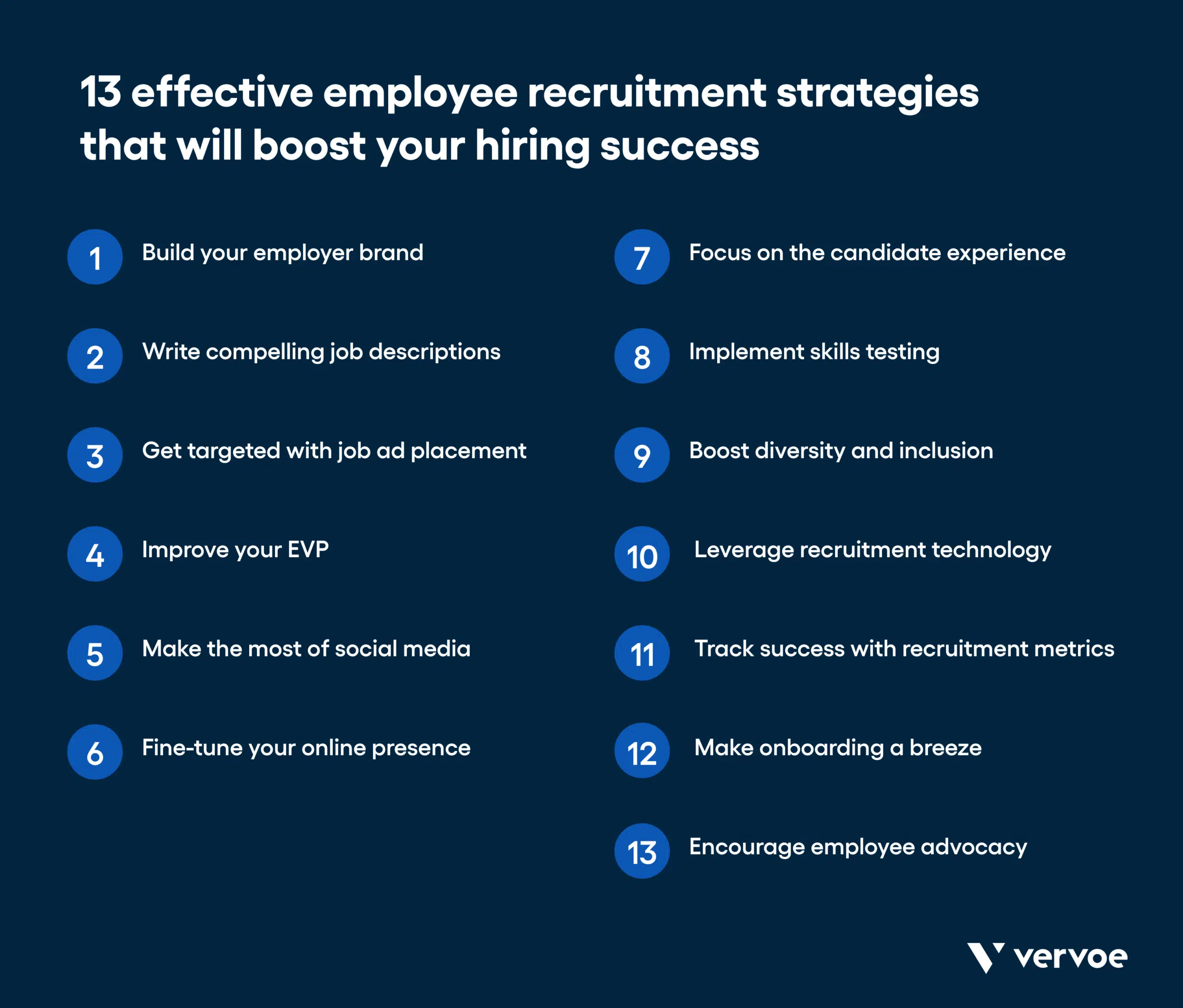
1. Build your employer brand
Why should candidates consider working for your business? How can you broadcast your culture and values, and what are the factors that can help you stand out from the crowd?
Companies can build their employer brands by ensuring they have a great careers webpage, plenty of written or video employee testimonials, and showing potential candidates what a day-in-the-life might look like in your team.
Be sure to keep track of your online reputation. What are your current and former employees saying about what it’s like to work at your company online? If there are negative reviews on sites such as Glassdoor, acknowledge these, follow them up, and ask your employees to write some positive reviews to provide balance.
Do: Link your employer brand to your overall company brand. If your company persona is funky and fun, your employer branding should match.
Don’t: Make claims that aren’t true. New hires will quickly spot a discrepancy between the employer brand and reality when they start work and may be tempted to leave if there’s a significant mismatch.
[Read more: How Employer Branding Improves Recruiting]
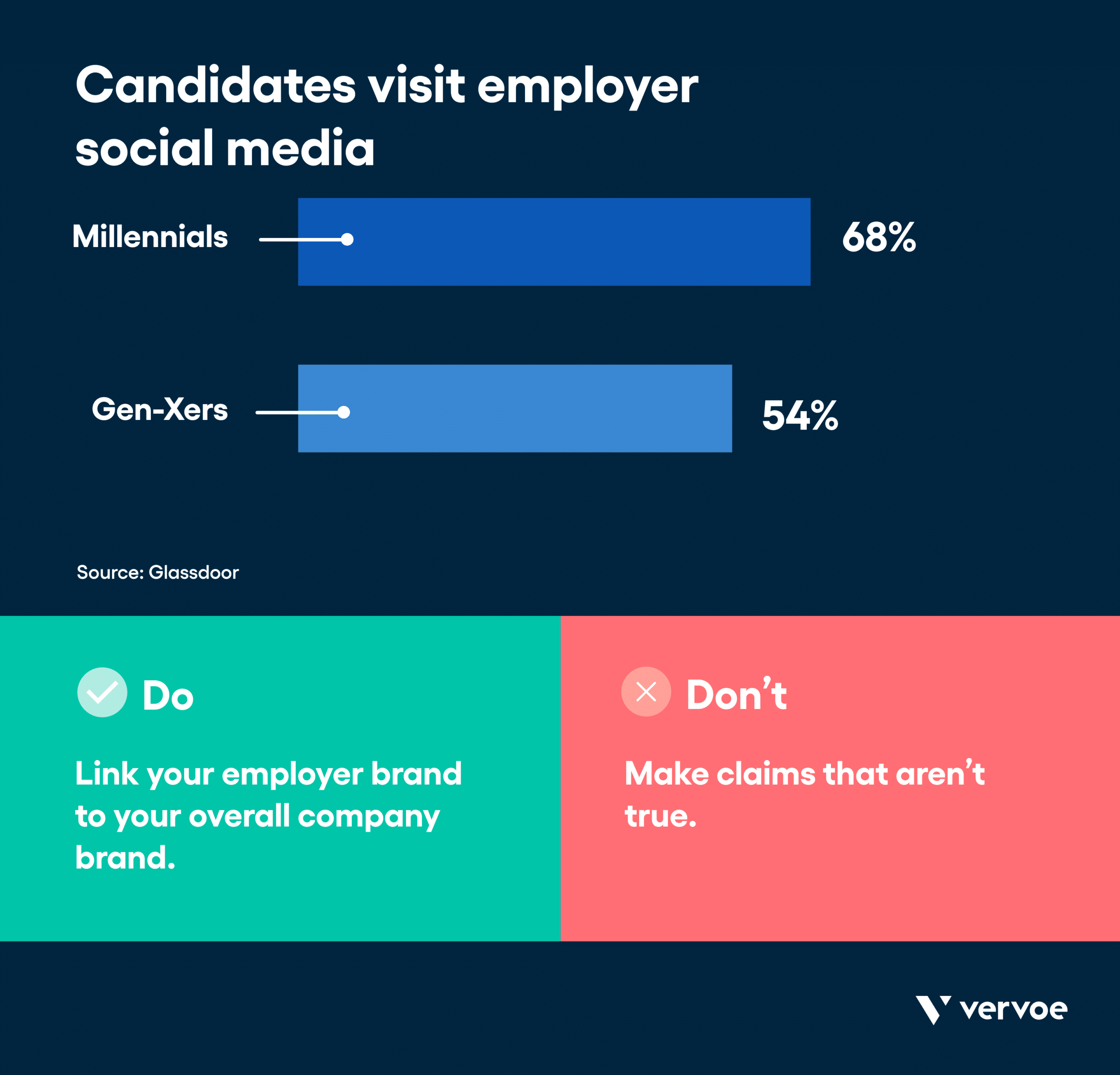
2. Write compelling job descriptions
For every great job ad published, there are a thousand boring ones. Make yours stand out by keeping it short and specific. Consider SEO to improve discoverability, and mix up the format by including embedded or linked videos along with the text.
Your job ad should begin with the most compelling aspect of the role. Perhaps it’s a brand-new position. Maybe it comes with great career opportunities, or maybe it’s the perks that stand out. Lead with this, rather than burying it five paragraphs down.
Use the opportunity to promote your organization’s culture and values, and watch out for non-inclusive or gendered language that could discourage people from applying.
Key stat: Short job posts under 300 words lead to 8.4% more applications than longer posts.
Do: Put some time and effort into writing job ads. They may feel like a chore, but they’re your best way to encouraging interested candidates to hit the “apply” button.
Don’t: Hide the salary range. 61% of candidates say the salary is the most important piece of information in a job description.
[Read more: Write Powerful Job Postings to Attract the Best Candidates]
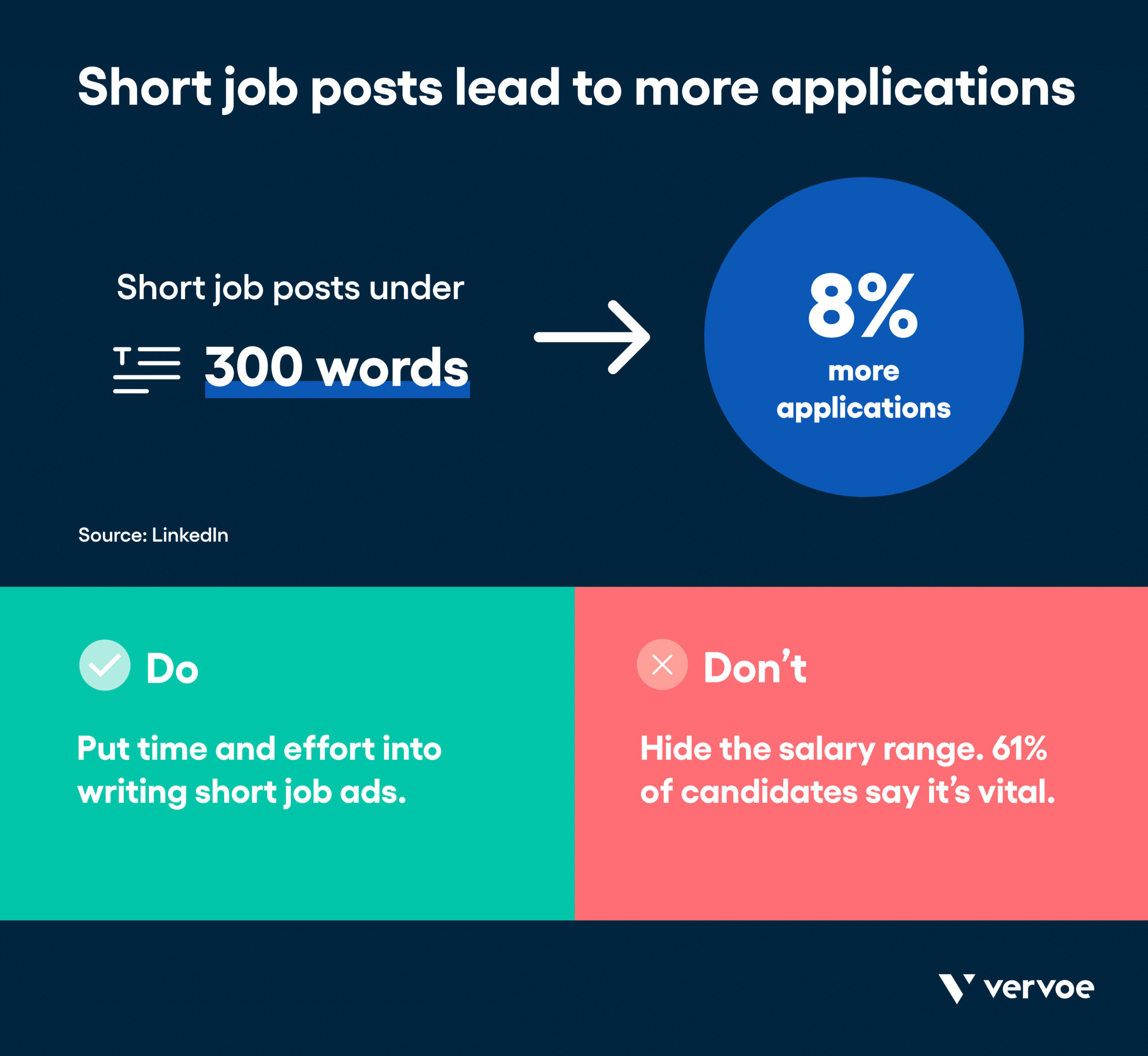
3. Get targeted with job ad placement
One of the best recruitment tactics is being smart about job ad placements by researching where your candidates spend their time online. While generic job boards can be effective, many industries have niche job boards that lead to improved results. Are your ideal candidates searching for jobs on Engineering.com or ArtsHub? Many traditional industries still place job ads in printed publications, while others focus on social media job ad placement.
Keep in mind that the aim isn’t only to boost applicant numbers, but to boost the number of relevant applicants with the right skill sets.
Job sites are by no means the only or best way to recruit employees. Other candidate sources include your career site, social media channels, recruiters, and employee referral programs.
Do: Track your source-to-hire to understand where to best invest your job ad placement budget.
Don’t: Take a scattergun approach to job ad placement and hope for the best.
[Read more: Remote Hiring Guide: How To Attract, Hire and Retain Remote Employees]
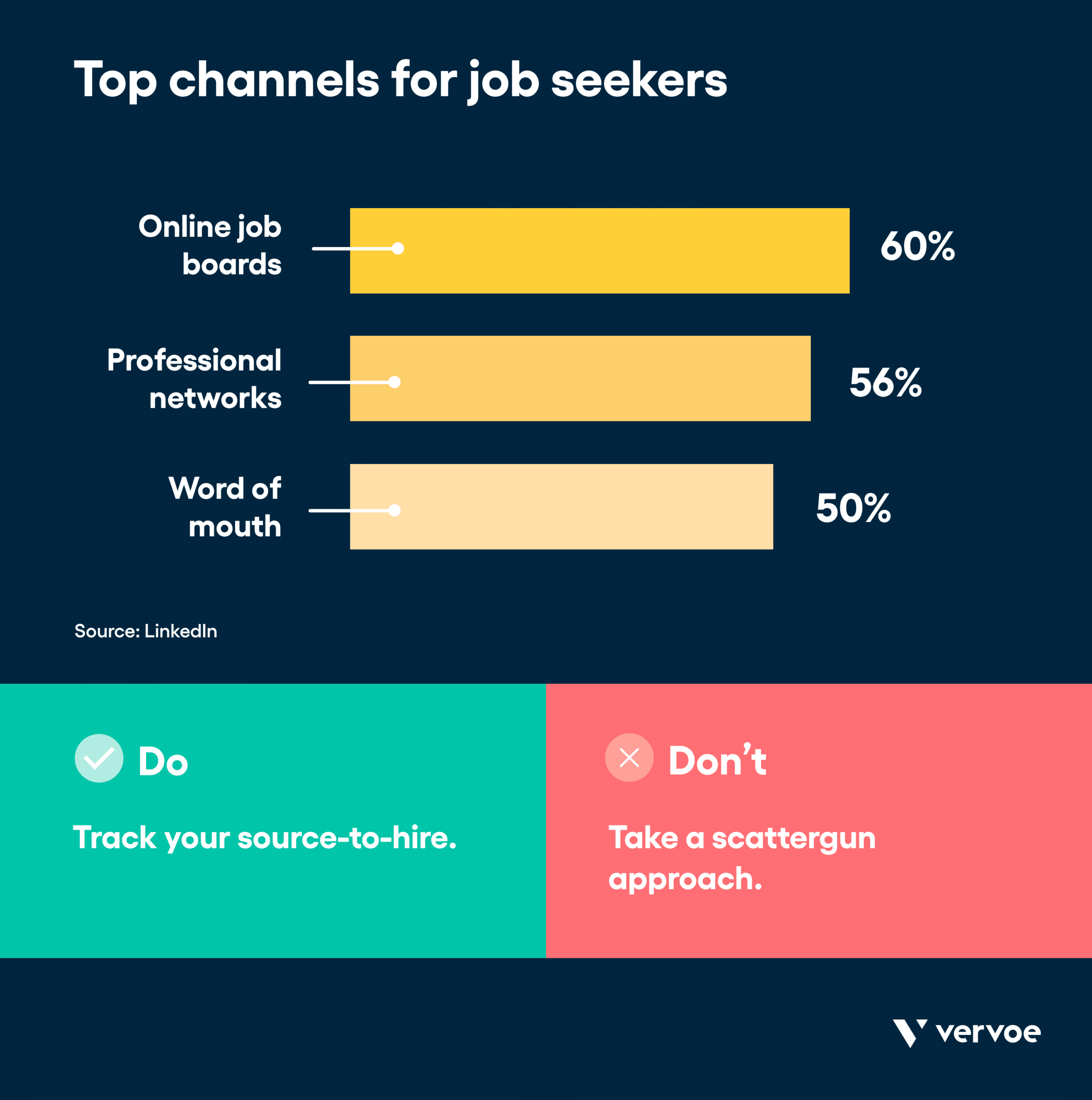
4. Improve your Employee Value Proposition (EVP)
Your Employee Value Proposition (EVP) is the package of incentives that are used to attract candidates. Salary is a key part of any EVP, but it shouldn’t be relied upon as the only incentive.
Consider improving employee recruitment techniques by including the following in your EVP:
- Flexibility, both in terms of remote working and flexible hours
- In-office perks, including comfortable and fun office spaces with facilities such as office gyms, great coffee, or ping-pong tables
- Remote-working perks such as membership for their local coworking space
- Additional days of personal leave
- Volunteering days
- A strong company culture and values that resonate
- Cutting-edge technology
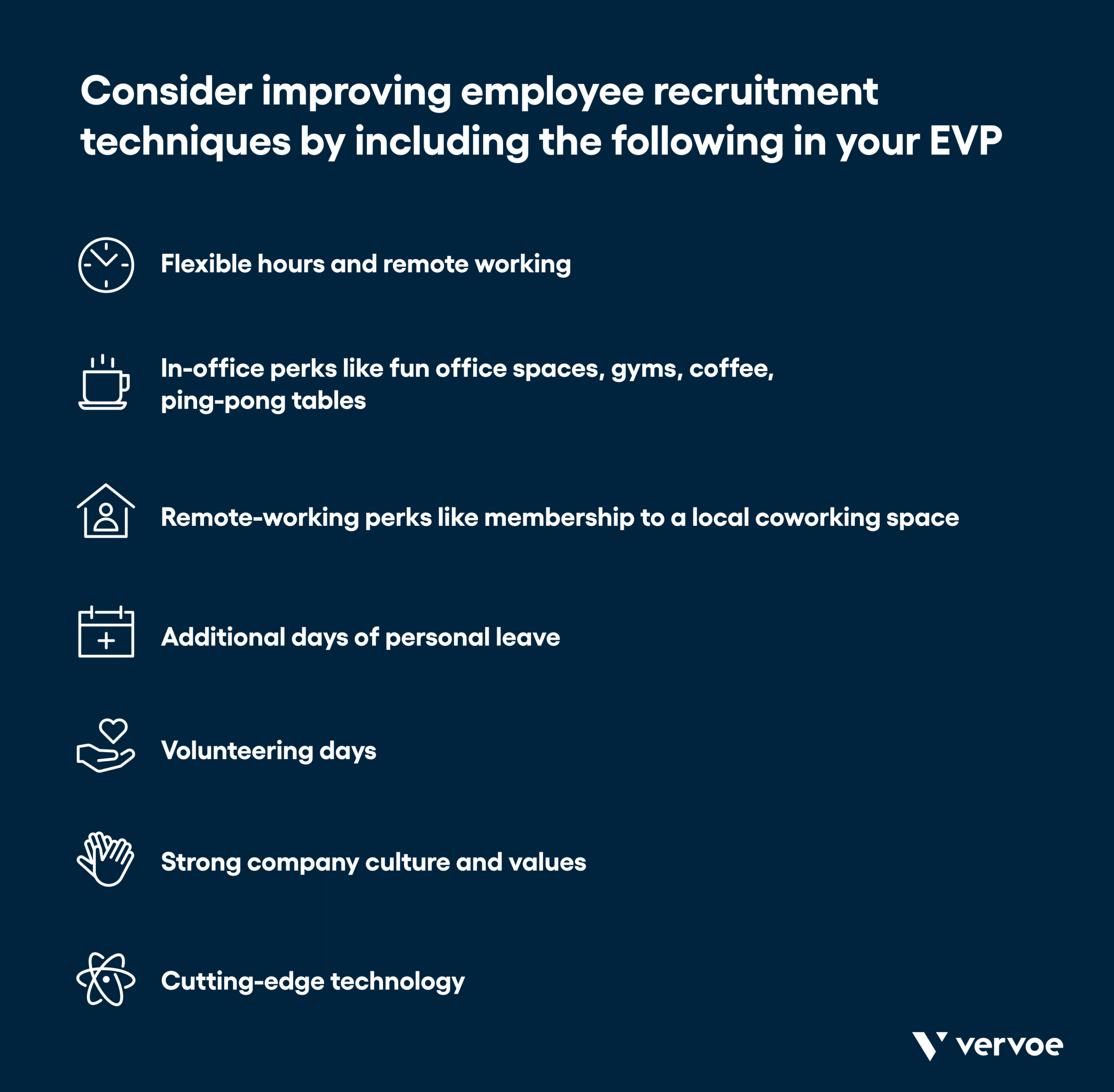
Do: Broadcast the highlights from your EVP in your job descriptions.
Don’t: Fail to differentiate your EVP from your competitors.
[Read more: 13 Inspiring Employee Value Proposition Examples To Attract Great Talent]
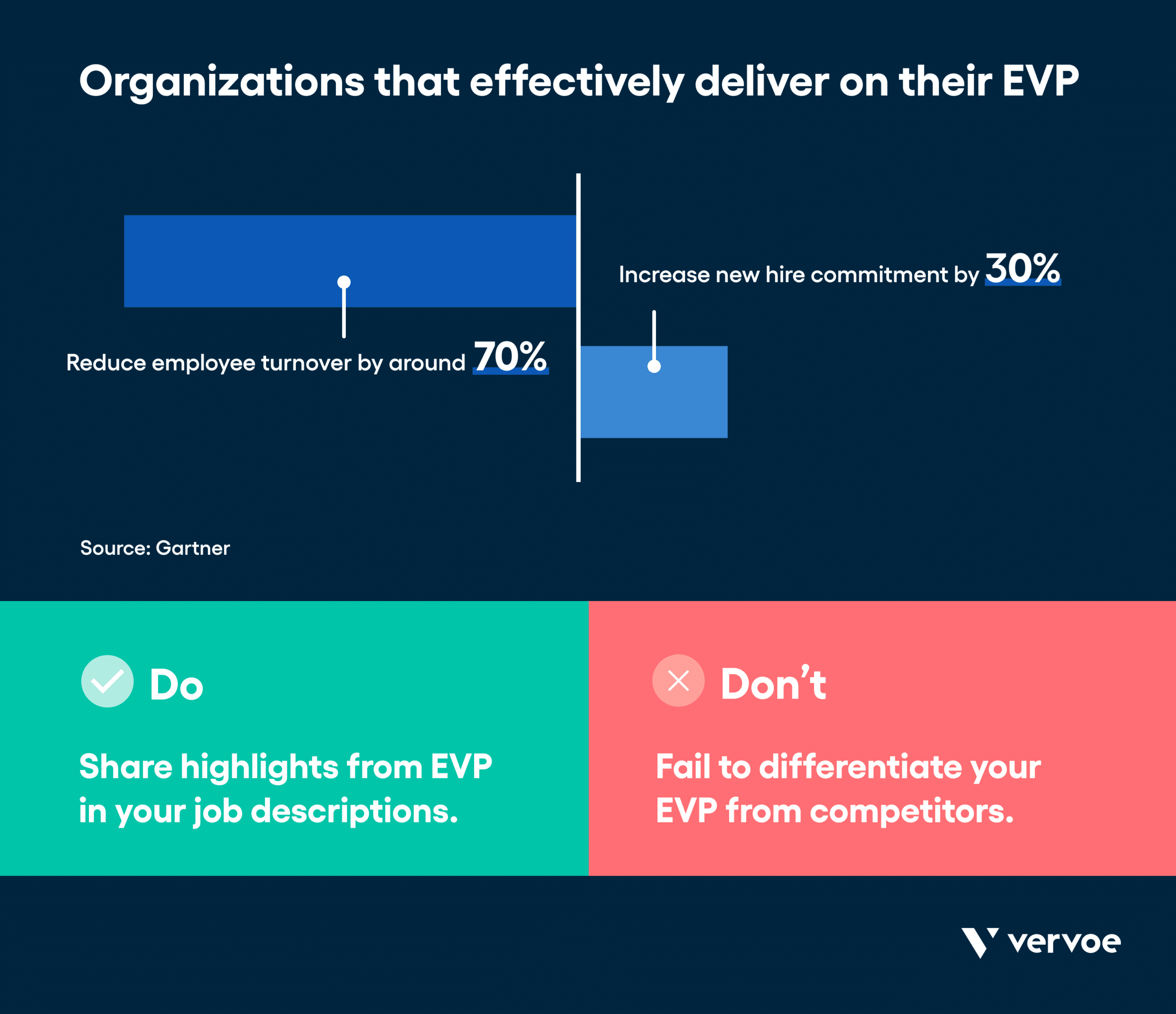
5. Make the most of social media
It’s easy to spot the companies that understand the power of social media recruitment. They have strong presences across popular channels, their Youtube accounts are brimming with career-related videos, and their employees are regularly advocating for their brand online.
Make social media one of your most effective recruitment strategies by:
- Creating candidate personas to determine who your audience is
- Determining the right social media channels for your needs
- Tracking metrics that count, for example measuring click-throughs rather than views/likes
- Developing great content such as videos, graphics, and articles
- Posting regularly and engaging with your followers by responding to posts and comments
- Boosting your candidate search capabilities with tools such as LinkedIn
- Boosting the reach of your job ads with promoted (paid) posts
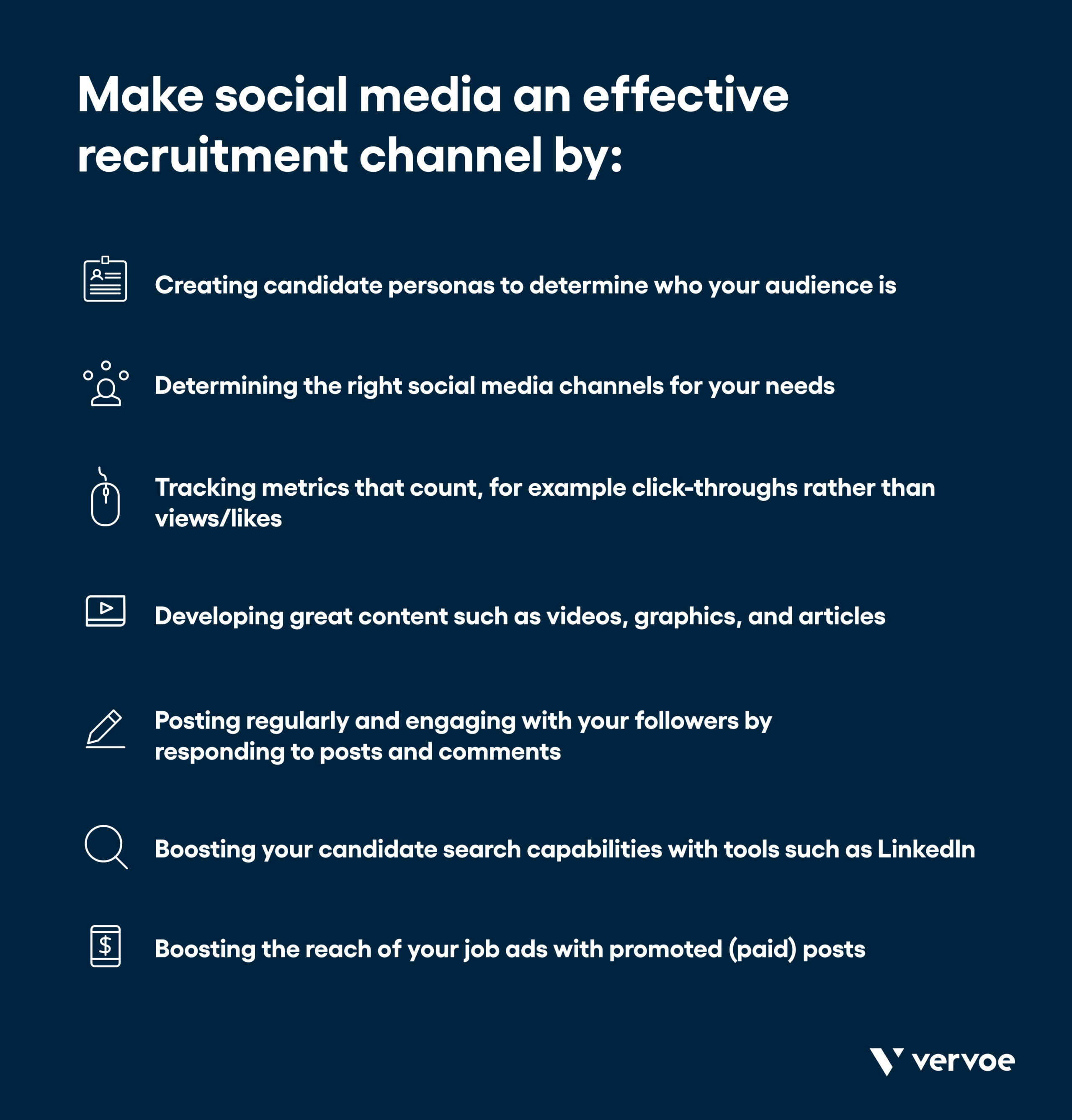
Key stat: 84% of organizations incorporate social media in their hiring processes.
Do: Look for ways to provide value to social media followers, such as sharing relevant content.
Don’t: Take a set-and-forget approach to social media. Post regularly and keep engaging with comments.
[Read more: How To Recruit and Hire With the Best Social Media Recruitment Strategies]
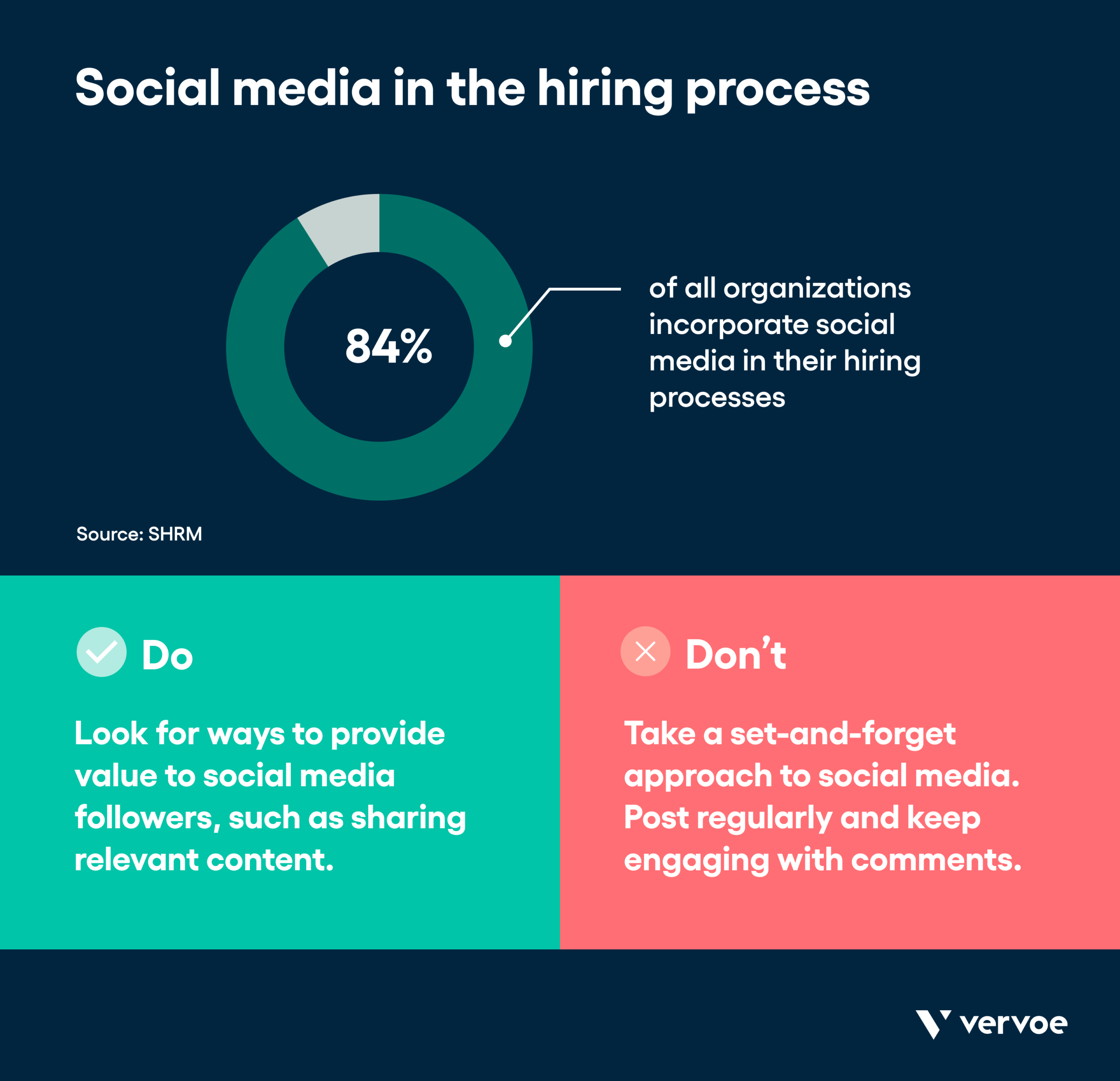
6. Fine-tune your online presence
If you only hire talent in your local geography, it’s likely candidates already know of you by reputation. But the rise of virtual hiring and remote working now means that companies are seeking talent in distant places, including other countries.
The key challenge when hiring virtually is that your online presence is the only thing remote candidates see. This means that a sub-standard website or non-existent social media presence can sabotage your otherwise effective hiring strategies.
Nothing beats Google as a tool for reviewing your online presence. Identify areas where you need to invest in targeted improvements, such as:
- The overall company website (work with Marketing on this)
- Your website careers page
- Social media channels
- Video and article content
- Employee advocacy
- Review sites such as Glassdoor
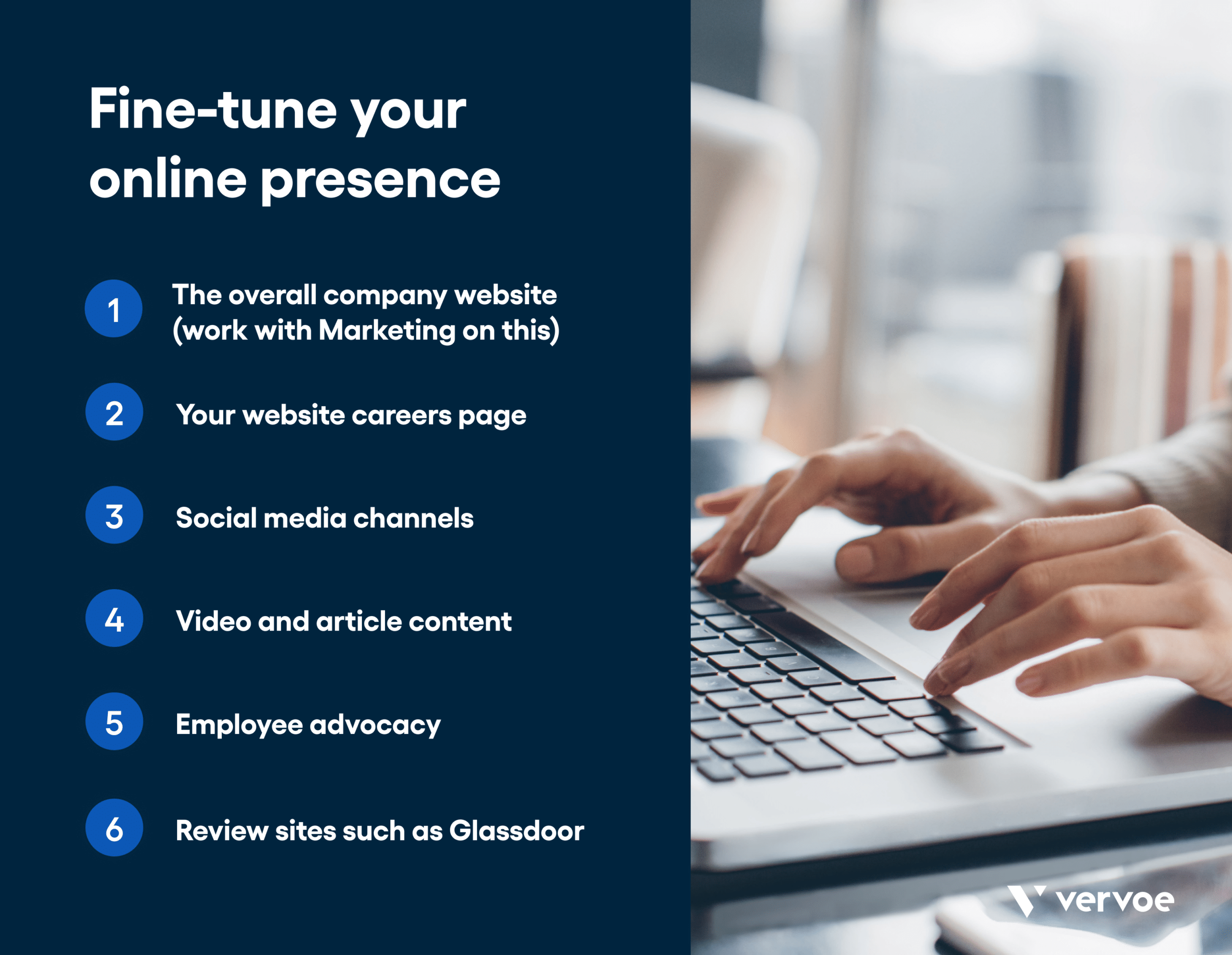
It’s also important to be aware of any negative press about your organization, even though this may be beyond your control.
Do: Revamp your website every three to four years to avoid it becoming outdated.
Don’t: Assume that checking a candidate’s digital footprint is a one-way process. In all likelihood, they are doing the same to you.
[Read more: How To Build a Strong Employer Brand Online]
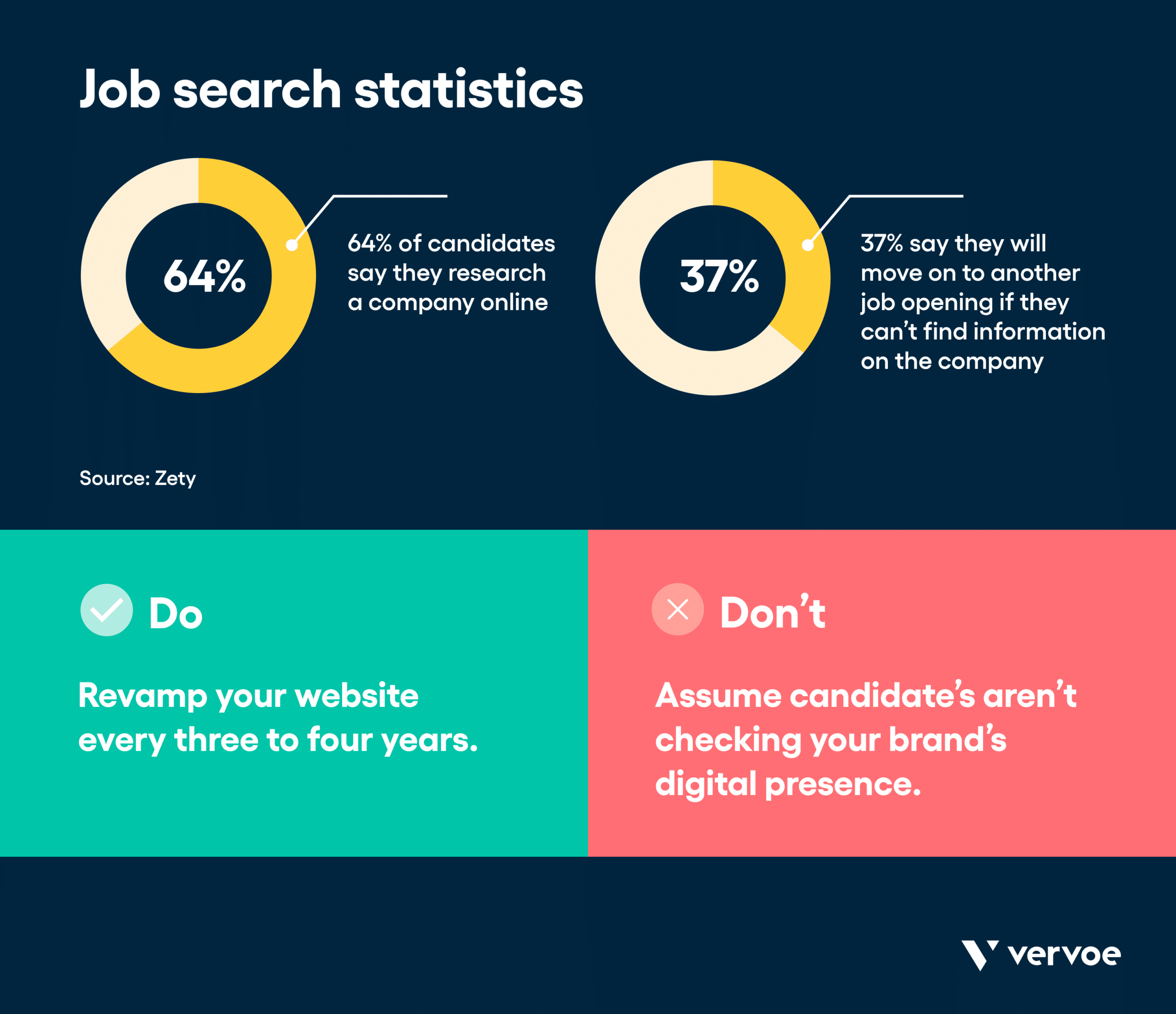
7. Focus on the candidate experience
A poor candidate experience will lead to an HR recruitment strategy falling down, and talent dropping out of your recruitment funnel due to frustration or impatience, and never coming back. Worse, it can lead to your company getting a reputation for poor hiring practices and undermine the company recruitment strategy.
A poor experience might be caused by:
- Insufficient candidate communication
- A complex and lengthy application process
- Too many rounds of interviews
- Lengthy or delayed hiring decision-making
- Unprofessional conduct such as canceling an interview at the last minute
- A “robotic” experience where the candidate feels the process is too automated
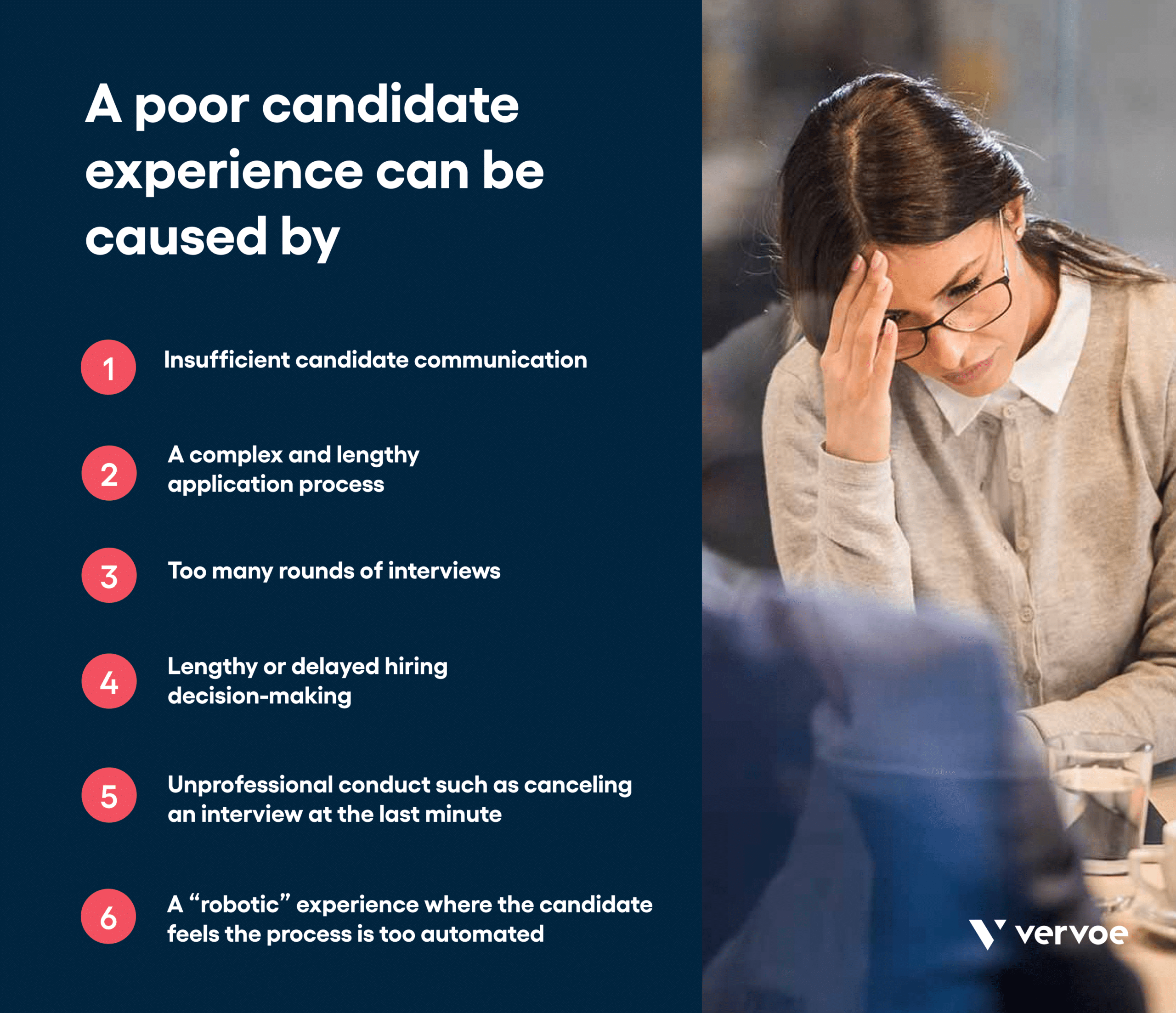
The candidate experience should align with your company brand. For example, if your company creates cutting-edge apps, a candidate would be disappointed to find themselves embroiled in a paper-based process.
Gather candidate feedback about the recruitment experience to understand what’s working and how to improve your recruitment strategy. The ultimate marker of success is when even unsuccessful candidates report positively on your hiring process.
Key stat: 60% of candidates have quit an application process because it took too long.
Do: Apply for the role yourself to identify bottlenecks and clunky processes.
Don’t: Forget that candidates are often customers, too.
[Read more: 6 Expert Steps to a Great Candidate Experience]
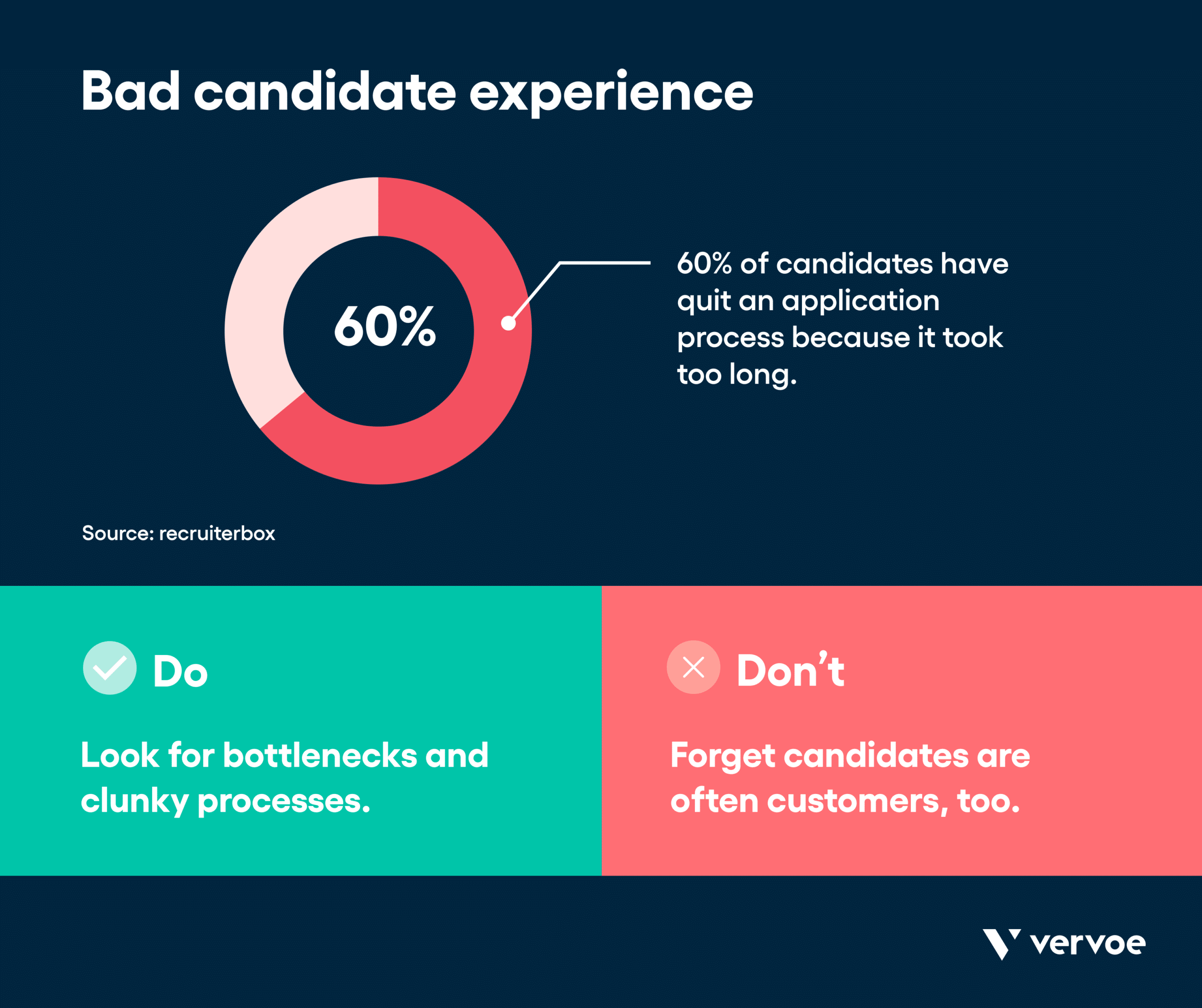
8. Implement skills testing
A well-written résumé and confident performance in the job interview are a good start, but unfortunately, they are not reliable predictors of future job performance.
The only true way to predict hiring success is to see how a candidate does the job, before they get the job.
Skills testing is a high-impact screening tool that rapidly separates the wheat from the chaff in your recruitment funnel. A targeted assessment will test candidates on the skills that matter to you (both technical and soft skills), and automatically rank your candidates by score.
Hiring managers can then drill deeper into assessment insights to identify areas of strength and weakness to address in the job interview.
Skills testing is an effective recruitment strategy and practice that improves fair hiring practices, minimizes bias, reduces turnover, and improves hiring outcomes.
Do: Make your skills test user-friendly, engaging, and not too lengthy. Focus on the candidate experience.
Don’t: Make hiring decisions based solely on résumés or job interview performance.
[Read more: Everything You Need to Know About Skill Testing]
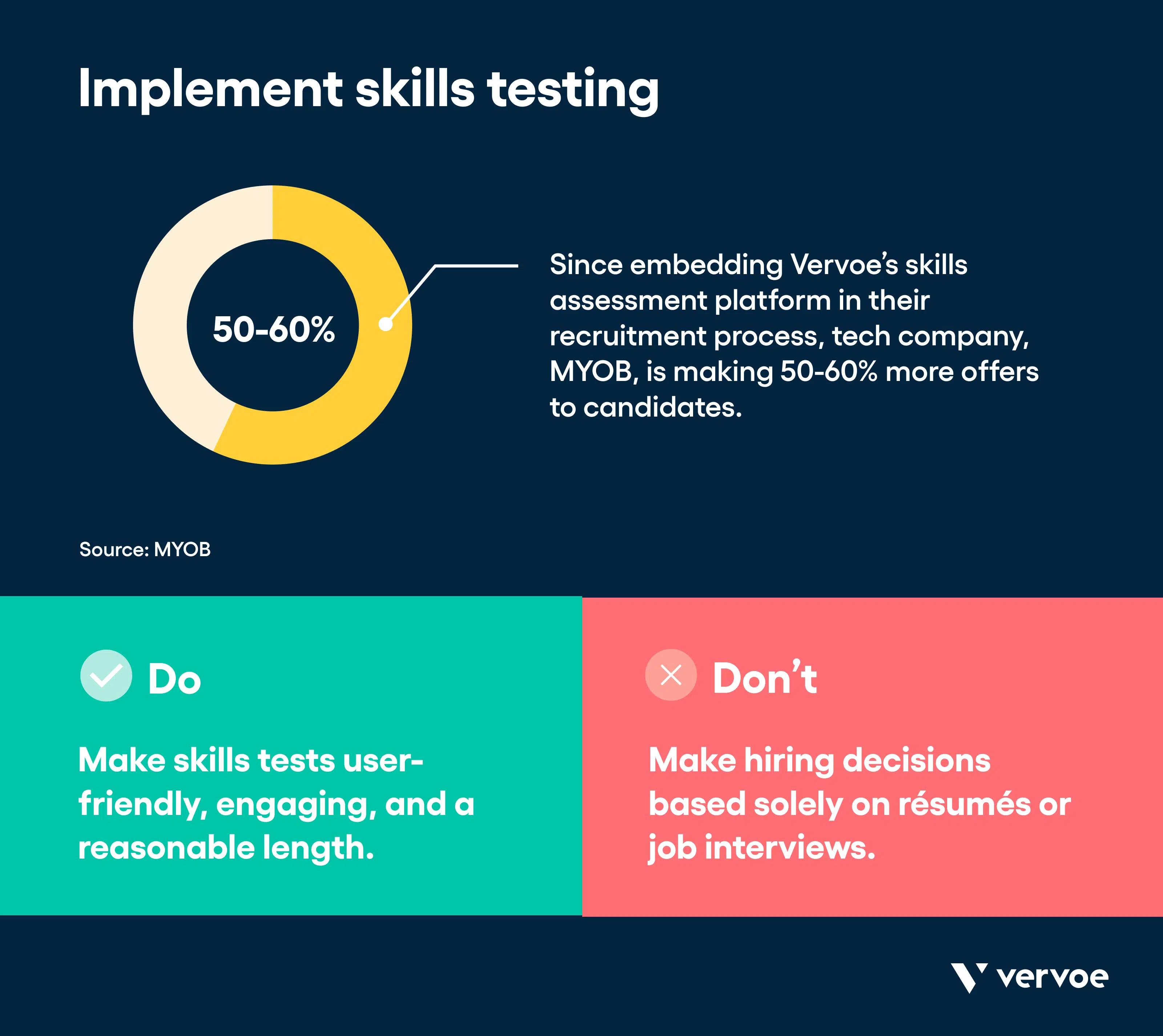
9. Boost Diversity and Inclusion
Diversity and inclusion (D&I) is no longer just a moral imperative: it makes business sense. Diverse teams outperform non-diverse ones by 35%, while 57% of employees think their businesses should be more diverse.
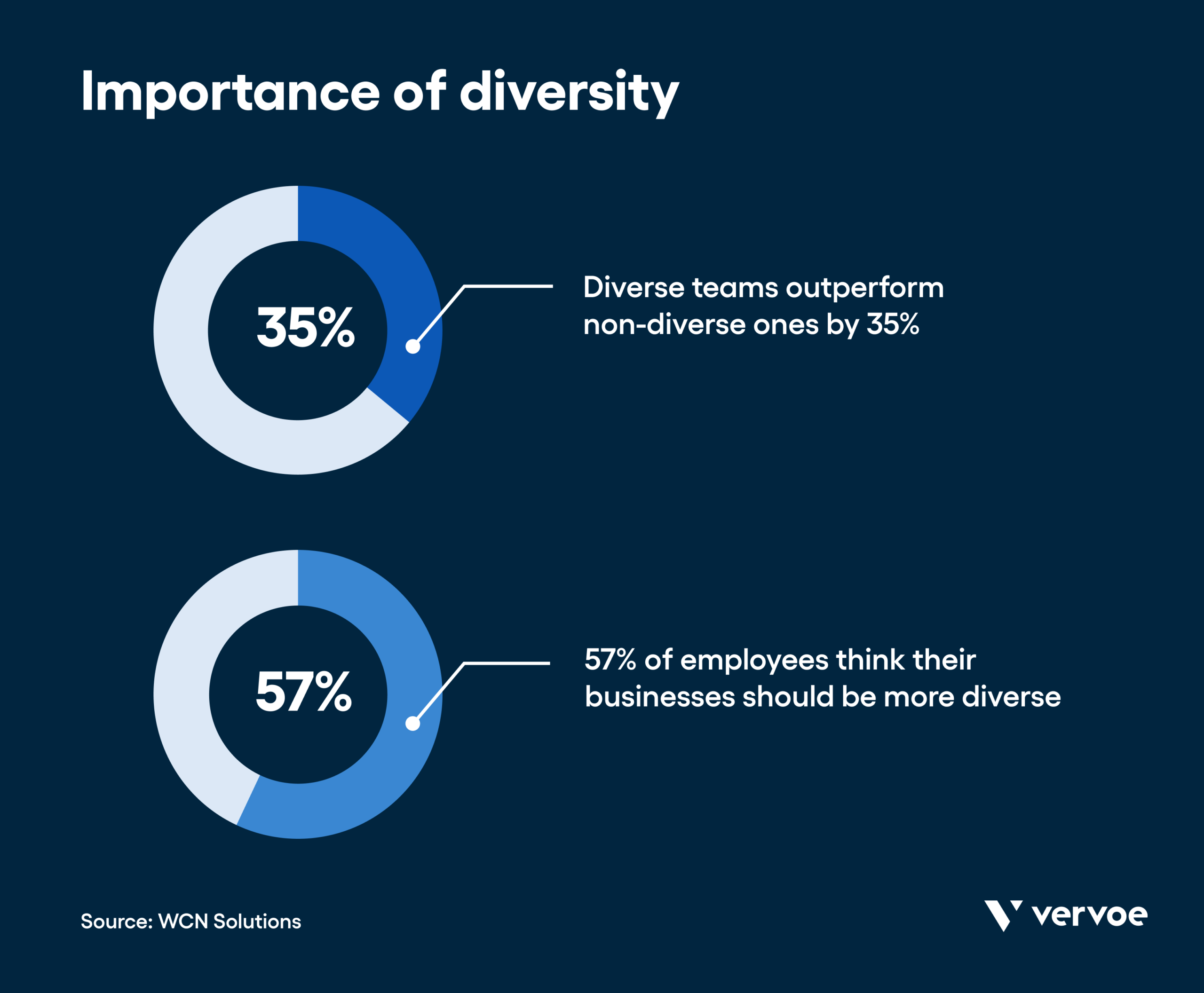
While diversity involves bringing more employees from different backgrounds into the business, inclusion means making sure their voices – and particularly their ideas – are heard. D&I boosts innovation, helps attract top talent, and improves financial performance.
Boost diversity hiring by:
- Getting commitment to D&I from leadership
- Hiring more diverse leaders
- Ensuring your job descriptions are inclusive
- Diversifying your job ad placements
- Minimizing bias in your end-to-end recruitment process
- Implementing merit-based skills testing
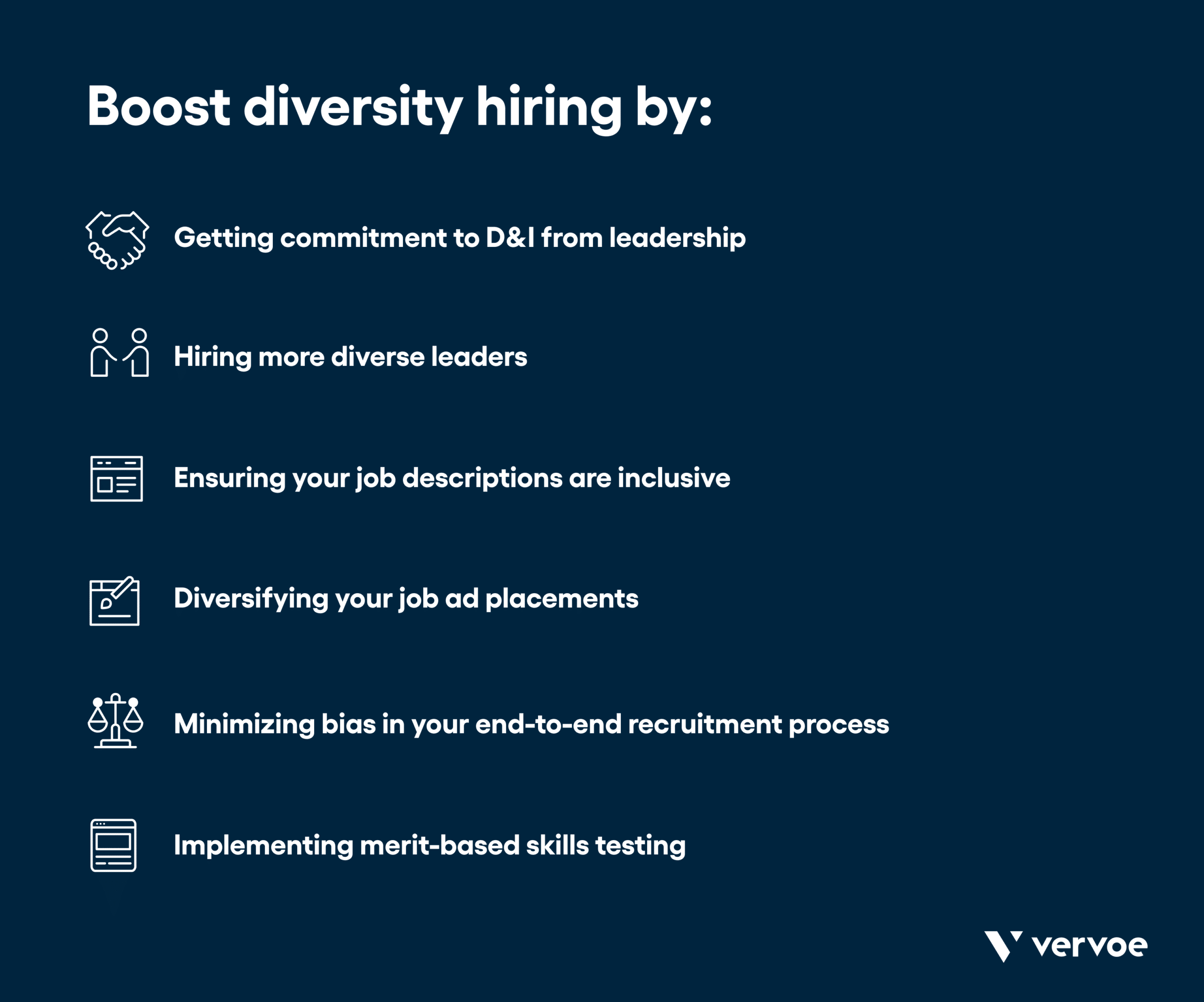
Key stat: Companies with above-average diversity achieve 19% higher innovation revenues.
Do: Analyze your recruitment process to identify areas with potential for biased decision-making.
Don’t: Simply change your policy and assume diversity will happen on autopilot. Diversity hiring takes commitment.
[Read more: The Ultimate Guide to Diversity Hiring]
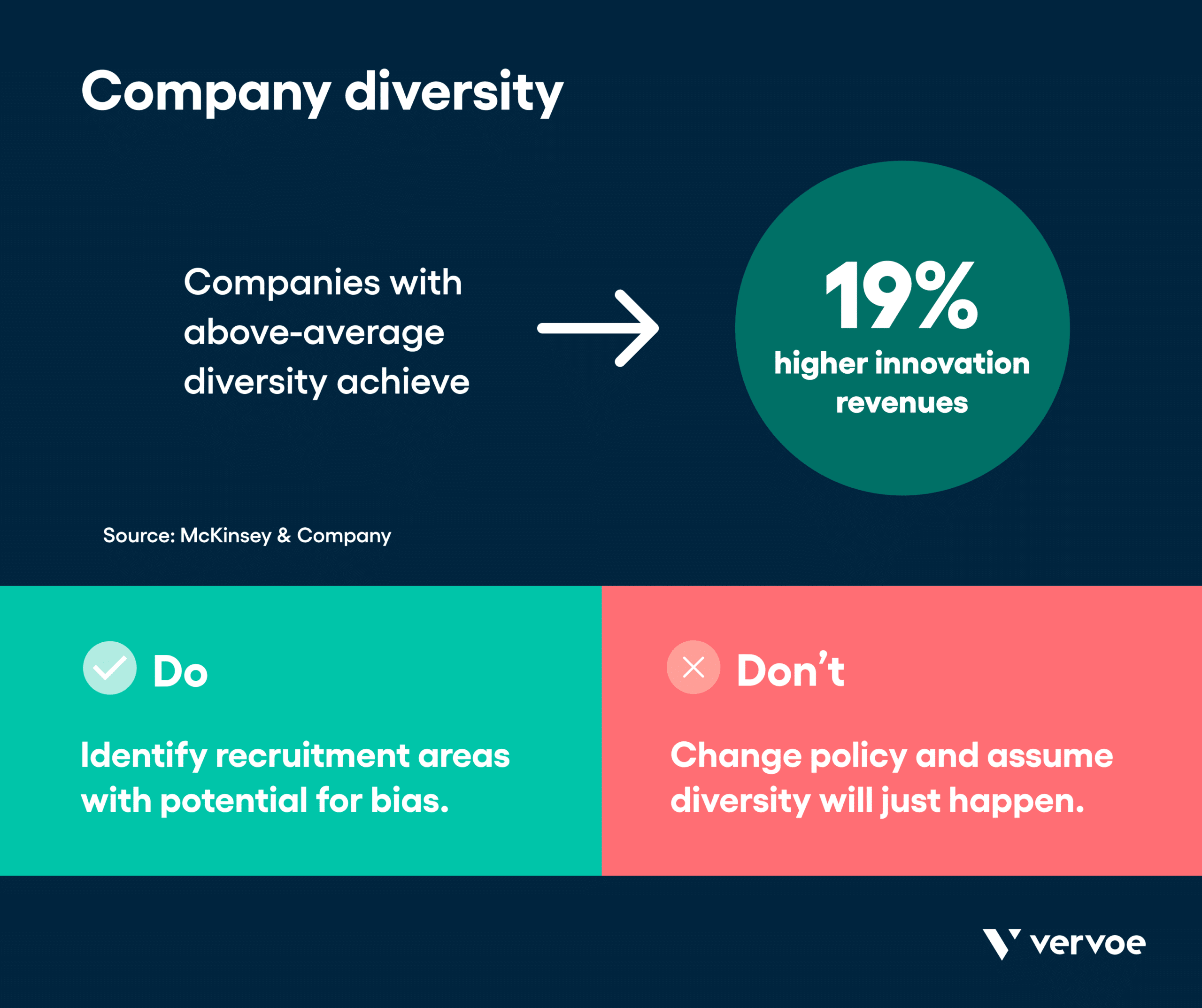
10. Leverage recruitment technology
While it’s possible to manage low-volume hiring manually, doing so creates a great deal of admin work and quickly becomes untenable when you attempt to recruit at scale. Technology can be used to improve your hiring and recruiting strategies, find efficiencies, automate processes, promote fairer hiring, and improve the candidate experience.
There’s a bewildering array of recruitment tech available on the market, but as a starting point you may want to consider:
- An Applicant Tracking System (ATS)
- Recruitment marketing software
- Résumé screening software
- Skills assessment software
- Interview scheduling tools
- Recruitment AI and machine learning
- Video interviewing platforms
- Automated candidate communication
- Online onboarding software
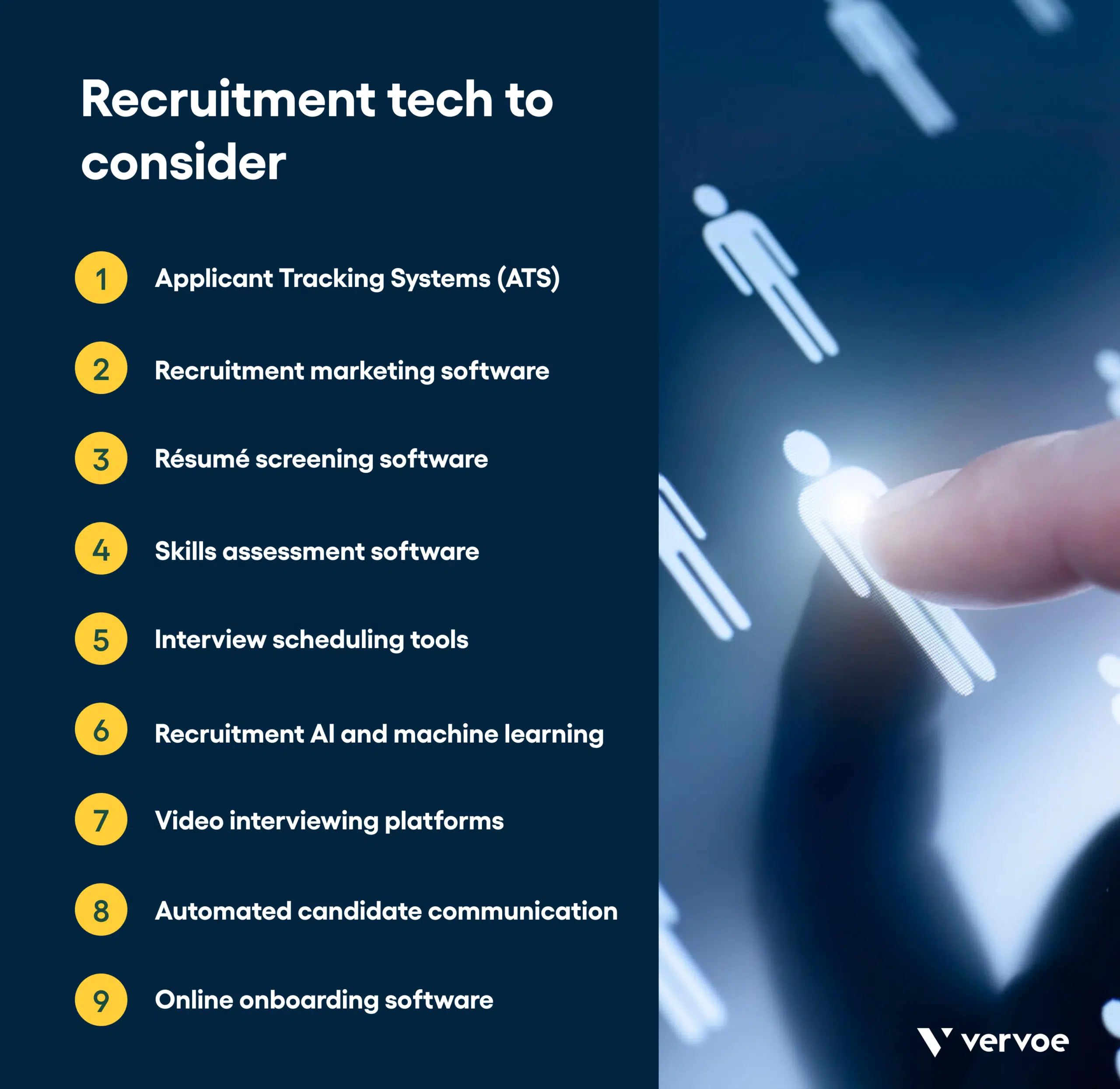
Don’t be talked into buying recruitment tech by the first salesperson you meet. Consider whether the technology is suitable for your strategic hiring practices, how it will integrate with existing systems, how much it will cost, and how it will improve hiring outcomes.
The key when implementing recruitment software is to balance the candidate experience with efficiency through automation. Even automated communication can be warmly written and personalized.
Key stat: HR managers lose an average of 14 hours a week manually completing tasks that could be automated.
Do: Start small by building a tech stack of best-in-class, integrated recruitment technology.
Don’t: Compromise on having a great candidate experience when automating your recruitment process.
[Read more: AI and Automation in Recruitment]
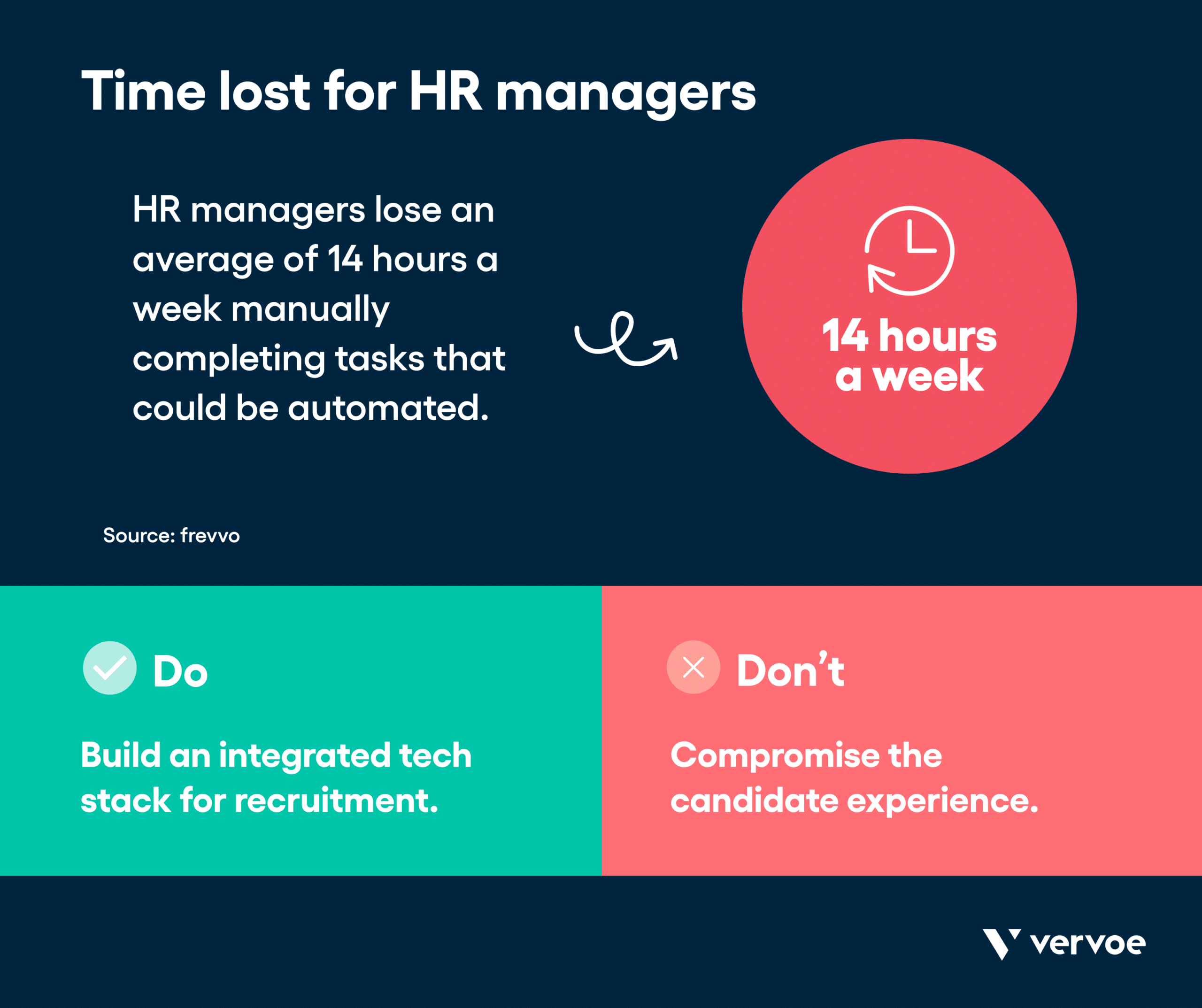
11. Track success with recruitment metrics
What can’t be measured, can’t be improved. Recruitment metrics are used to measure, track, and improve key outcomes at various stages of the recruitment funnel to ensure you’re following the best recruitment strategies. Common metrics to track include:
- Quality of hire
- Time to hire
- Cost per hire
- Applicants per hire
- Source of hire
- Hiring diversity
- Candidate experience
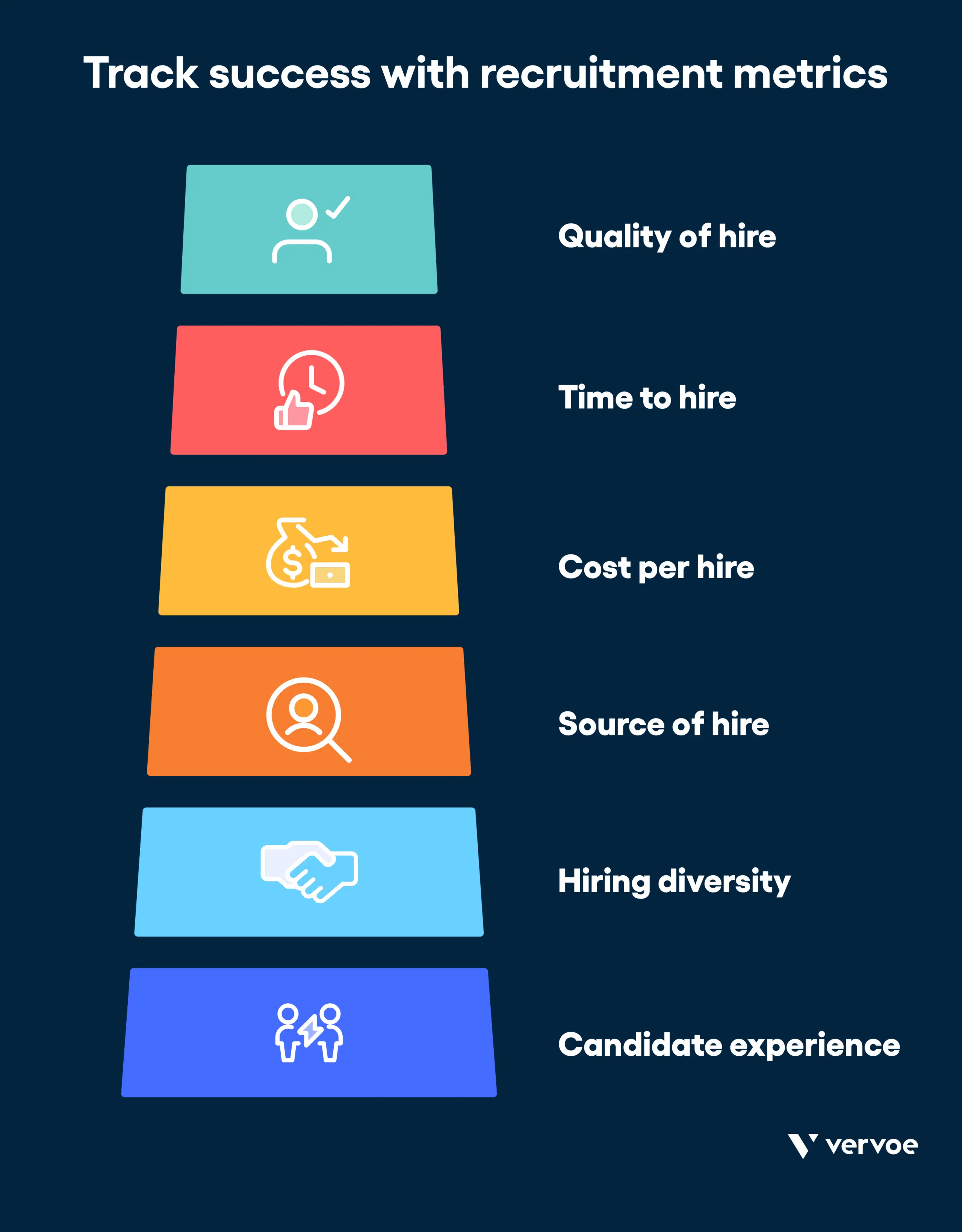
There are dozens of other recruitment metrics to track, but rather than trying to manage them all, use the metrics that reflect your organization’s current priorities. For example, if the business is focused on controlling costs, it pays to track time to hire and cost per hire.
How do you measure success? It depends on the metric. Time to hire, for example, is calculated by counting the days between the application and the day the successful candidate accepts a job offer. Hiring diversity is tracked with the help of demographics surveys.
Key stat: The three most popular recruitment metrics to track are source of hire (57%), time to hire (50%), and applicants per hire (42%).
Do: Use recruitment metrics to drive continuous improvement.
Don’t: Forget to align the metrics you are tracking to overall business objectives.
[Read more: 6 Crucial Metrics To Measure Your Recruitment Funnel Effectiveness]
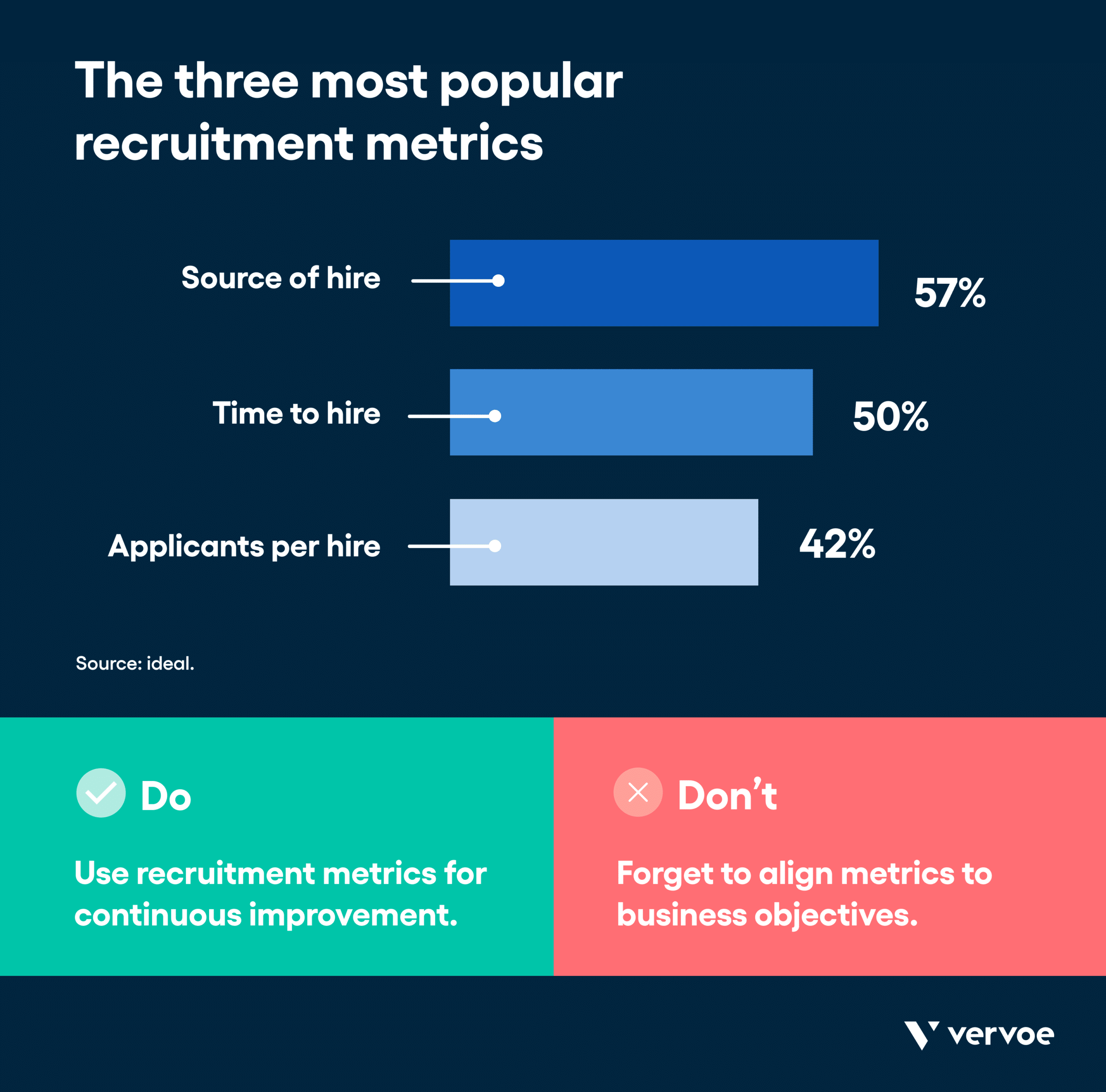
12. Make onboarding a breeze
Great onboarding can boost retention and enable your new hires to reach full productivity faster. Onboarding is an opportunity to ensure new hires stay excited and engaged, make sure they are set up for success, and tick the necessary compliance boxes.
Onboarding software can be used to:
- Reduce or eliminate paper processes
- Boost engagement between job acceptance and day one
- Get more admin tasks out of the way before day one
- Make sure nothing gets forgotten (such as arranging a desk or system access for the new hire)
- Integrate data such as compliance and training program data with other systems
- Focus on ensuring a great candidate experience that isn’t a let down after the excitement of winning the role
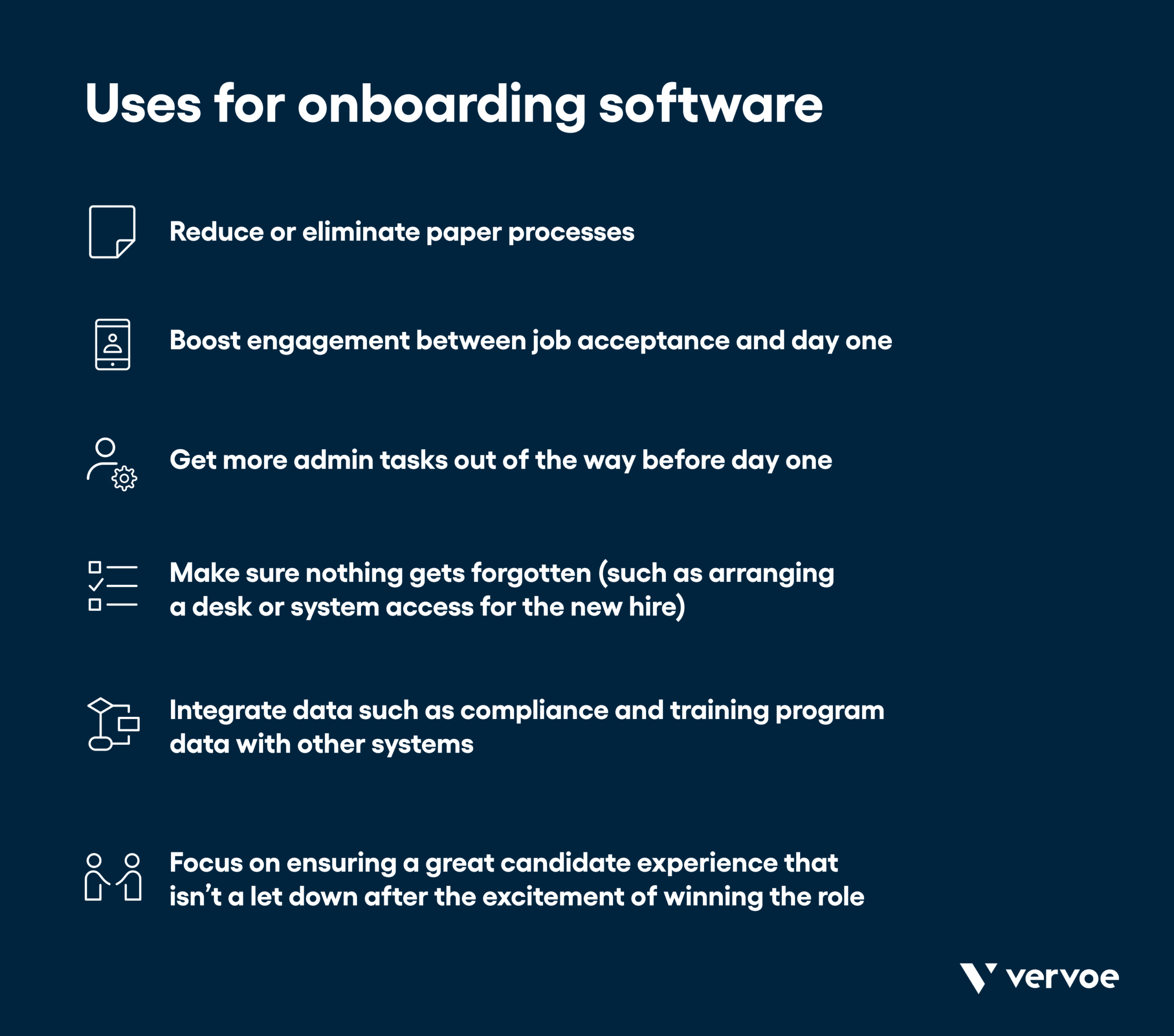
Key stat: Great onboarding can improve employee retention by 82%, yet 88% of organizations don’t onboard well.
Do: Make onboarding as fun and engaging for the new hire as possible. Include information such as what to expect on their first day, what they should wear, where they can find a great café, and so on.
Don’t: Make onboarding predominately about filling in forms and ticking boxes.
[Read more: Remote Onboarding Guide]
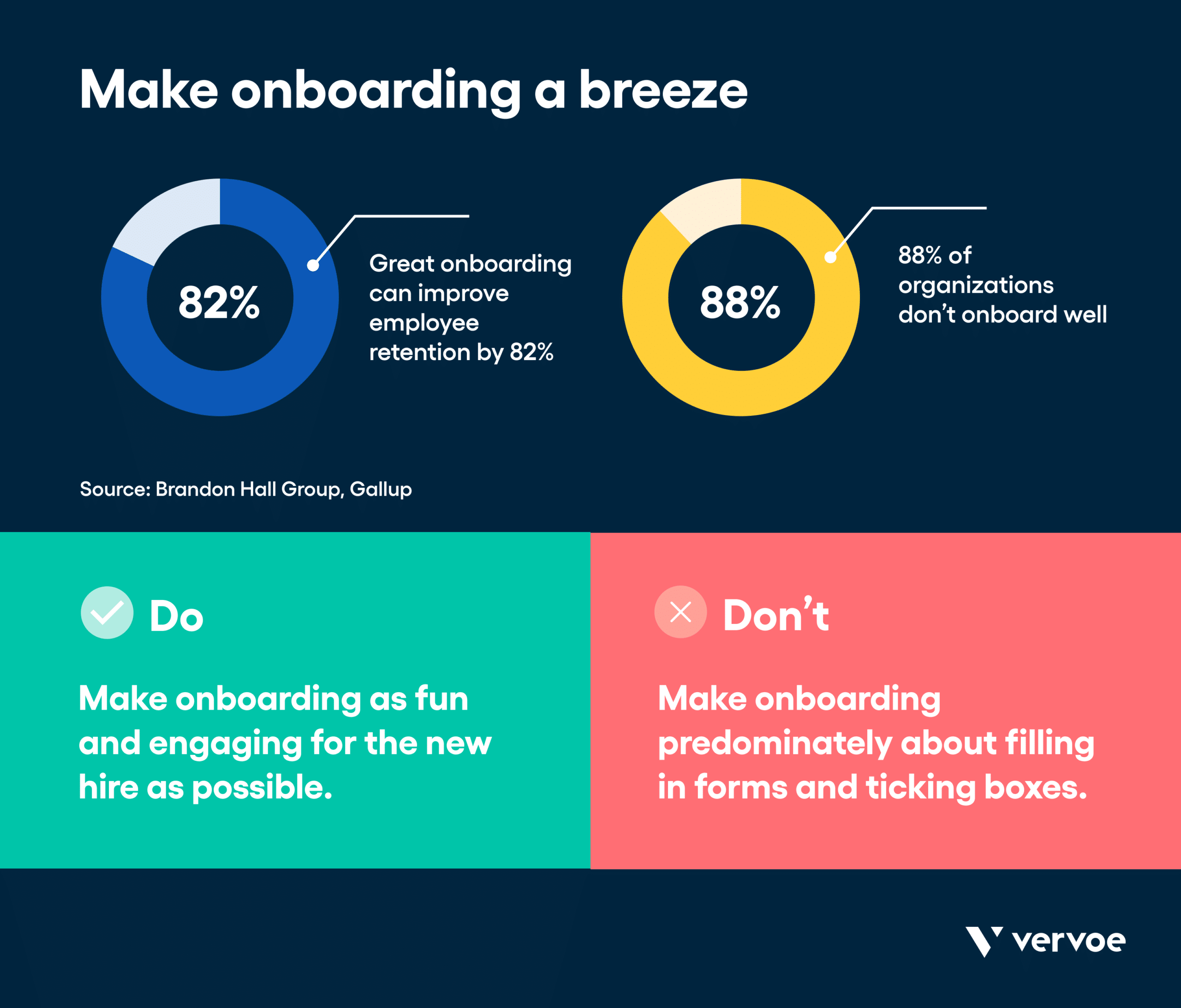
13. Encourage employee advocacy
Your current employees are an untapped resource for attracting more great quality candidates and improving your hiring brand. Importantly, potential candidates are much more likely to trust information from real employees than they would from a brand.
Ask your team to help by:
- Leaving positive reviews on rating sites such as Glassdoor
- Writing positive posts about your company on social media
- Sharing job ads with their networks
- Participating in recruitment marketing, such as video interviews
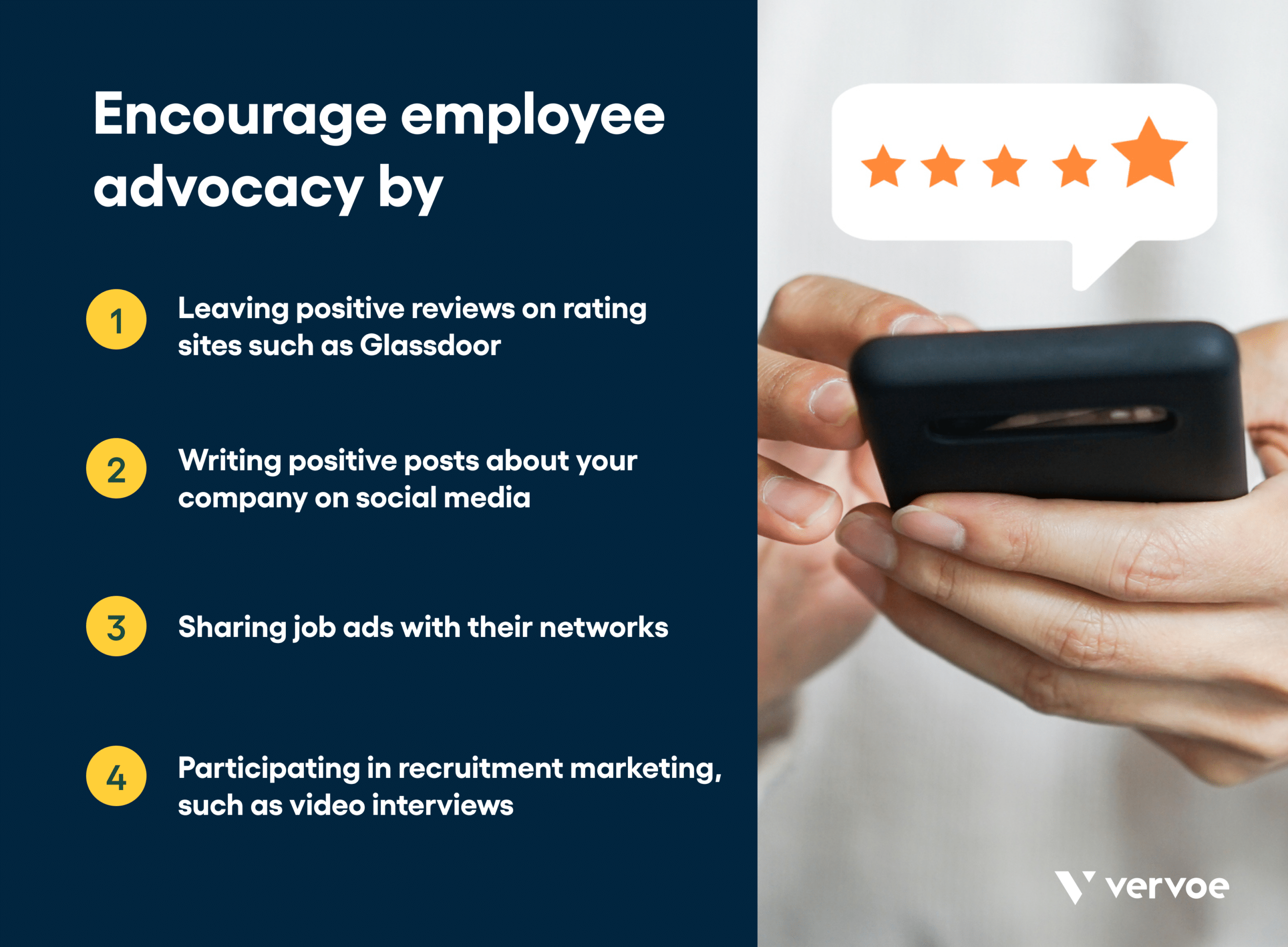
Employee referral programs are cheaper and faster than traditional recruitment techniques. They also have high applicant-to-hire conversion rates and can lead to improved retention. However, referral programs can lead to lower diversity, can stifle innovation, and can tempt managers to hire without going through the usual due diligence.
Key stat: Messages shared by employees went 561% further than the same message shared on a brand-owned channel.
Do: Use real employees in your recruitment marketing whenever possible.
Don’t: Try to force employee advocacy. Empower and incentivize your employees to share positive messages online, but don’t mandate it.
[Read more: Are Employee Referrals Still the Holy Grail of Recruiting?]
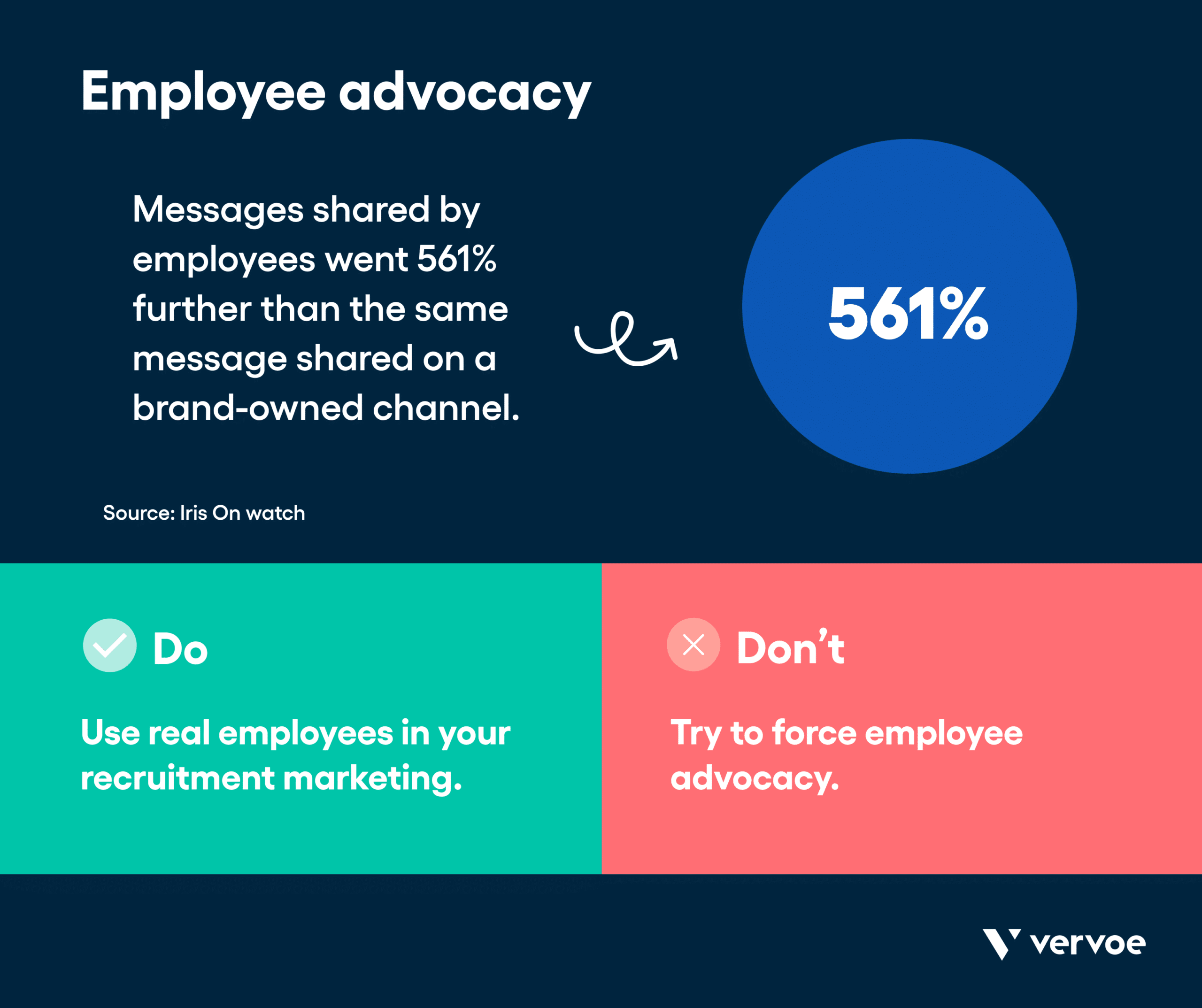
Final thoughts
Don’t wing it in recruitment. Getting strategic by using some or all of these recruitment techniques will help you hire better and drive continuous improvement along your entire recruitment funnel.




















